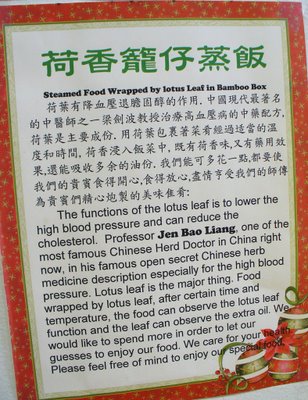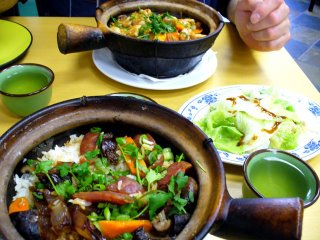Taishan Cafe

I'm talking about the Taishan Cafe restaurant.
My co-worker, whom I'll refer to as "G-spot", tipped me off to Taishan after listening to me complain, day in and day out, about the fact that Hong Kong Claypot City is now a dim sum restaurant. G-spot, Taiwanese by birth, has also led me to some interesting finds in the last 2 years, including uber-dive - Star Lunch. Anytime, I feel the need to ask "exactly what is Quickly?" or about weird flavors at 100% Healthy Dessert, he's da man.
So when he told me about a place on Clement that specializes in claypot, where no one speaks – nor is anything written in – English, I knew I had to go...and drag Bruce along with me.
The mere fact that this place may have scared off the gweilos with its lack of English signage or, yes, speakage (how's that for English?), put it at the top of my dive priority list; right underneath "Fear Factor". Of course, being somewhere people don't speak or write English doesn't scare me.
I grew up in the Confederacy, you know.
That, and I had an excellent translator with me.
Taishan, for the most part, falls in the gray area of what I consider a dive since, although it's a small, relatively cheap, mom-and-pop-owned place that has old ladies and construction workers as regulars, and even a bit of the fear factor (for non-Chinese speakers), it's new, clean, and, so far, without a place in the history of the neighborhood.
I use to love eating at Hong Kong Claypot City. Back in the day (ok, it wasn't that long ago), it was the best, if not hottest (as in temperature), place in Chinatown to get a steaming hot claypot of chicken and salted fish. The other place, Utopia Café, got more attention from the guide books, but their claypot was no match for HKCC. Even though HKCC was on Grant and had the foot traffic – mostly tourists wondering why they were suddenly in a place that unabashedly served frog – it also had a strong following of locals, both Chinese and non-Chinese, who both knew and appreciated it.
I've been looking for a Chinatown replacement to HKCC ever since it changed it's menu, but unfortunately nowhere I've been comes close (although the chicken, mushroom, and lop chong claypot at The Garden Restaurant on Kearny is pretty good).
So even though Taishan was out of my immediate vicinity, I felt it was worth a trip over to Clement and Park Presidio to check it out.
At first glance, G-spot was right. Almost everything is written in Chinese. Luckily I found out the name beforehand, since I probably would've had a hard time figuring it out.
Since I can't read Chinese, I'm not sure if Taishan refers to the famous mountain in the Shandong province or the area directly west of Hong Kong in the south. Since I heard the owner say "thank you" to customers in both Mandarin and Cantonese (basically the only Chinese I know), I was confused even more.
I take it that the huge nighttime photograph of (what I assume is) downtown Hong Kong, which stretches along the upper part of a side wall in Taishan, suggests that the namesake refers to the province of Taishan, not the mountain.

In the end, I guess it doesn't matter since I'm really here for the claypot experience, not a geography lesson. But how about a history lesson?
Did you know that the majority of Chinese immigrants to North America prior to the 1970s were Taishanese? And that the Taishanese language (a dialect of Cantonese) was the main language spoken until then? In fact, one of Dive's loyal readers (and a dive-master in his own respect) is of Taishanese descent.
Right, Leland?
After walking into Taishan, we were immediately seated at a side table under the previously mentioned photo of Hong Kong. In front and behind us were Chinese laborers chowing down some grub before heading back to work, as well as a table full of old women seated by the window. I could hear some kind of commotion from the back of the restaurant which later turned out to be eight men (also laborers) who had just finished their meal and were making their way back to work.
The owner graciously thanked them and made small talk as they walked single-file out of the restaurant. Just then, a young couple with a small child walked in and got the super-gracious treatment from the owner. These folks were obviously regulars, and the owner seated them like they were family.
Or, in the case of those of you who come from families that annoy the shit out of you, this means they were treated nicely, as opposed to being resented and nagged at.

It's a small restaurant and, other than the glossy wall photo above us, and the menus printed on Christmas and birthday paper posted on the wall at each table, the place is pretty much a no-frills establishment. The tables and chairs were noticeably without the well-worn usage that comes from years of serving hungry people, and for small things in life such as these, I’m always grateful.
One sign on the wall was kindly translated into English, which provided us with more entertainment and good-natured laughs than the original author probably intended. I mean, who knew that lotus leaf was still the "major thing" and that both the leaf and the food can "observe" each other?

Despite the fact that everything else seen and heard was in Chinese, there was, luckily, a menu in both Chinese and English to accommodate the rest of us non-Taishanese/Cantonese/Mandarin speakers. The menu probably should've had better descriptions of the dishes rather than "House Combination Claypot", but then we wouldn't have had the pleasure of having the owner explain to us that "combination" included yellow eel and frog.
Yeah.
These folks must be from Southern China. It's been said that the Cantonese eat anything whose back faces the sky, although occasionally the Japanese give them a run for their money.
From perusing the menu, I quickly realized that Taishan specializes in two things: claypot and food "wrapped in lotus leaves steamed in a bamboo box" (actually an everyday, run-of-the-mill bamboo steamer).
While I'm sure the steamed lotus leaf dishes were fine, that's not why I drove all those miles from the backseat of the car the whole way here. I 'd decided, before I even left the house, that I would have a claypot dish, even if it killed me - so, kindly, talk to the hand with all that steamed food stuff and murder me with some claypot already.
Keeping with the season and my current obsession with preserving things, I ordered the Preserved Mixed Meat claypot while Bruce decided on the less exotic Chicken and Mushrooms claypot.
While we waited, we were served hot tea and pork consommé.

Sometimes I can judge the quality of a restaurant based on their pork broth. Because it's such a common thing in Chinese restaurants, cheap tasting soup can sometimes warn you ahead of time about what the rest of your meal will be like. Luckily, the soup here was tasty. The tea was average, but fresh and not the recycled tea bags stuff you find in your typical dive joint.
Soon after we finished our soup, our food arrived one by one, with Bruce's chicken and a side of braised cabbage drizzeled with oyster sauce arriving first. When the claypot came to the table, it was still covered, darkened and heavy looking – and no doubt scorching hot. This was apparent when the lid was lifted and a cloud of steam bellowed upwards as the sound of rice still sizzling on the bottom could be heard.

On top of the sizzling white rice were medium-sized chunks of chicken coated in a thin, transparent sauce of some kind, slices of shitake mushrooms and carrots, diced green onions, and cilantro (aka, coriander).
The owner then brought Bruce a small dish filled with a thin brown sauce that had some slices of jalapenos in it and suggested pouring it over his food. When he does, even more crackling can be heard from the rice and a fragrant puff of steam rose once again from the pot.
My claypot arrives just when Bruce is ready to dig into his. Again, steam bellowing, sizzling rice, smoky smell of burnt rice on the bottom – you know where I'm going with this.
In addition to the same toppings Bruce had in his claypot (minus the chicken), there were chunks of Chinese sausage and dry-cured bacon.

This type of dish is one of my favorite uses of Chinese charcuterie, as the flavor from the sausage and bacon melts into the dish and is observed by the rice.

Many people wouldn't find this dish worthwhile since it's so mild - being flavored primarily by the meats. They also wouldn't enjoy the sweetness of the sausage or the fattiness of the bacon – or the fact that the rice on the bottom is burnt and crusty and gives the dish a faint smoky flavor.
They also would be turned off by the lack of English spoken here, the occasional gawking of an old lady amused to see Westerners using chopsticks, and the noticeable absence of sweet and sour pork and fortune cookies.
Luckily for them, there's Panda Express.
And luckily for me, there's Taishan.

Feel free of mind to pay them a visit sometime.
k.

1 Comments:
wow....you went to that taishan site and found me at taishan people???!!! ...cool! I thought no one goes there. nor give a lo-see hoon (rat's ass) about it. I figured if they listed former washingtong gov. gary locke, they can list me...and i'm surprised they listed me!
claypots are big in taishan city. but they so too much of it gives you too much "heat"...that yin and yang stuff about foods. 'nget hei' in taishan dialect.
i am surprised they have a shop run by taishaner's serving claypots. I'll check it out...though making a claypot myself is pretty easy.
thanks for mentioning me...i'm diving!
Post a Comment
<< Home